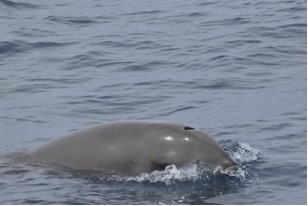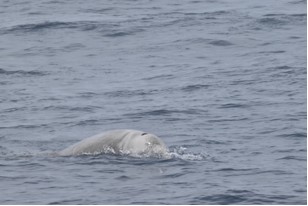Deep Sea Adventures And Deeper Sea Divers

When I was invited to intern for the 24-hour pelagic trip that was planned for June 3-4, 2022, I knew it was an opportunity I could not refuse. The chance to be on a boat for an entire day searching for offshore marine mammals, pelagic birds and other organisms seemed too amazing to turn down, and soon enough the evening came when the Cape May Whale Watch and Research Center and the Starlight Fleet set out to the deeper waters of the Canyons in the Atlantic Ocean. The night was spent traveling farther away from shore, but once first light arrived and we had reached a depth of more than seven thousand feet, our search for marine wildlife began.
With Wilson’s storm petrels and Great shearwaters beginning to appear at dawn, in addition to several species of dolphins in the distance within the first few hours of the day, one could only begin to imagine what the rest of the day had in store. The trip contained great sightings of various organisms belonging to different taxonomic groups. Common dolphins (Delphinus delphis), offshore bottlenose dolphins (Tursiops truncatus), loggerheads (Caretta caretta), basking sharks (Cetorhinus maximus), and countless oceanic sunfish (Mola mola) were only a few of the species that we were able to observe.
Amongst the many organisms sighted, one of the most memorable was Cuvier’s beaked whales (Ziphius cavirostris). Cuvier’s beaked whales are one of the larger beaked whale species; they are able to reach 23 feet in length and are found throughout most oceans (NOAA, 2021). Z. cavirostris have dark patches surrounding the eyes and are typically dark grey in coloration. This coloration tends to fade with age, leaving older individuals to have a paler appearance (Wursig et al., 2017). Z. cavirostris males have two teeth protruding from their lower jaw that resemble a pair of tusks, and it is thought that these “tusks” are utilized for fighting (NOAA, 2021).


Cuvier’s beaked whales also hold the record for the deepest dives made by a marine mammal. They have the capability of diving at least 3,300 feet and their deepest dive ever recorded was 9,816 feet! These mammals tend to dive into deeper waters to feed on squid and octopus, but occasionally, they also feed on fish and crustaceans (NOAA, 2021).

Cuvier’s beaked whales are known to keep their distance and very rarely do they decide to approach a vessel. This made our sighting all the more special and sometimes some marine mammals are just as curious about us as we are them!
-Michelle Carranza, Intern at Cape May Whale Watch and Research Center
Stockton University ’24
References
NOAA Fisheries (2021, December 29). Cuvier’s Beaked Whale | NOAA Fisheries (Alaska, New England/Mid-Atlantic, Pacific Islands, Southeast, West Coast). NOAA. https://www.fisheries.noaa.gov/species/cuviers-beaked-whale
Wursig, B., Thewissen, J. G. M. H., & Kovacs, K. M. (Eds.). (2017). Encyclopedia of marine mammals. Elsevier Science & Technology.
